
Catalog excerpts
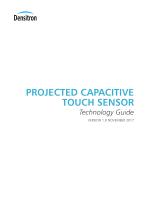
PROJECTED CAPACITIVE TOUCH SENSOR Technology Guide VERSION 1.0 NOVEMBER 2017
Open the catalog to page 1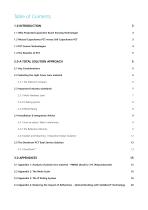
1.1 Why Projected Capacitive Touch Sensing Technology? 3 1.2 Mutual Capacitance PCT versus Self Capacitance PCT 3 2.2 Selecting the right Cover Lens material 5 2.4.3 Gasket and Mounting - Integration Design Guidance 12 2.5 The Densitron PCT Total Service Solution 13 3.1 Appendix 1: Analysis of plastic lens material - PMMA (Acrylic) v PC (Polycarbonate) 15 3.4 Appendix 4: Reducing the Impact of Reflections - Optical Bonding with SolisBond® Technology 20
Open the catalog to page 2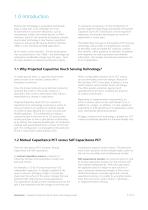
Touchscreen technology is everywhere and already plays a major part in our everyday lives. From its dominance in consumer electronics, such as smartphones, tablets and mobile devices, to ATM machines, point of sale terminals and games consoles, touchscreen technology is now having a significant impact on enhancing the Human Machine Interface (HMI) in more industrial and B2B applications. By no means a new invention - the first touchscreen was conceived back in the 1960s - this technology has undergone considerable change over the years. From the early iterations of resistive touchscreens...
Open the catalog to page 3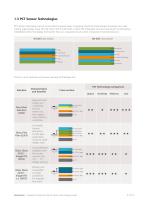
PCT sensor technology can be constructed in several ways. Emerging trends and technologies however have seen cutting edge design using On-Cell Touch and In-Cell Touch, where the integrated structure and touch functionality is embedded within the display itself rather than on a separate touch screen component mounted above it. In-Cell Cross-section On-Cell Cross-section • Glass • Touch Panel ■ Liquid Crystal Layer Glass Polariser The four most common and proven sensing technologies are: Characteristics and benefits Cross-section One-Glass Solution (OGS) Reduced stack height...
Open the catalog to page 4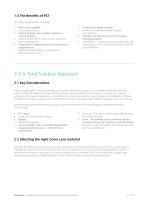
1.4 The Benefits of PCT PCT offers many benefits, including: • • • • • • Multi-touch capability Low activation force Sensing through cover window materials of varying thickness Enhancing the HMI to create a more consumerbased look and feel Integration of complex artwork printing and lens design features Maximum optical clarity, no shape loss or deformation over time Chemical and scratch resistant No drift over time eliminating the need to re-calibrate Extending the lifetime of a product through increased durability Availability in a variety of glass structures, from GG (Glass/Glass) to OGS...
Open the catalog to page 5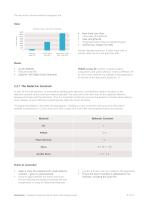
The two most common material categories are: Glass Resistance rating - Soda Lime v Gorilla Glass 16000 14000 @ 12000 -o 10000 8000 6000 4000 2000 0 Soda Lime Gorilla® Glass 2 Gorilla® Glass 3 with (with I OX) (with IOX) NDR™ (with I OX) • Basic Soda Lime Glass • Chemically strengthened. • Heat-strengthened • Toughened (also known as Tempered glass). • Gorilla Glass, Dragon Tail, NSG Greater damage resistance. It takes more load to initiate radial cracks in the glass (see left). Plastic • Acrylic (PMMA) • Polycarbonate (PC) • Optolite™ HSR (High Scratch Resistant) PMMA...
Open the catalog to page 6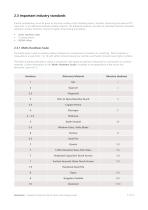
Careful consideration must be given to the outer surface of the finished product, whether comprising the external PCT cover lens, or an additional overlaid window material. The following outlines a number of important industry standards relating to surface hardness, moisture ingress, drop testing and sealing. • Mohs Hardness Scale • IP rating system • NEMA rating 2.3.1 Mohs Hardness Scale The Mohs scale is used to measure relative hardness of a mineral by its resistance to scratching. Mohs hardness is measured on a scale from 1 to 10 with softer minerals having low numbers and harder...
Open the catalog to page 7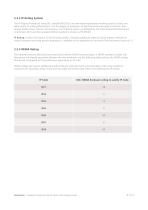
The IP (Ingress Protection) rating (IEC standard 60529) is an international protection marking used to classify and define levels of sealing effectiveness and the degree of protection of electrical enclosures against intrusion from foreign bodies (tools, dirt etc) and moisture. The IP Rating system is published by the International Electrotechnical Commission (IEC) and the equivalent British standard is known as EN 60529. IP Rating: Further information on the IP rating system, including additional tables on liquid ingress, mechanical impact resistance and solid particle protection, is...
Open the catalog to page 8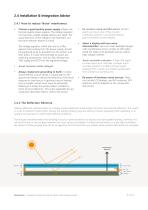
2.4 Installation & Integration Advice 2.4.1 How to reduce ‘Noise’ interference • Always implement grounding to Earth: A metal chassis behind a touch sensor is a good path to the ground and tends to reduce the sensitivity of the touch response in case there is a significant area of overlap. Such a metallic surface must never be electrically floating as it makes the whole product unstable in terms of touch detection. This is also applicable for any conductive decorative feature close to the sensor. Touch controller selection: A high-SNR signal to noise ratio touch controller increases touch...
Open the catalog to page 9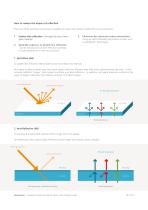
How to reduce the impact of reflection There are three common mechanisms available to reduce the impact of reflection on touchscreens: 1. Scatter the reflection - through the use of anti- 3. Eliminate the refractive index mismatches - glare coatings using an optical bonding lamination process such as SolisBond® Technology. 2. Optically suppress or absorb the reflection - by the introduction of anti-reflection coatings, circular polarisation or the use of louvres 1. Anti-Glare (AG) To scatter the reflected external light source and reduce its intensity. Anti-glare scatters incident...
Open the catalog to page 10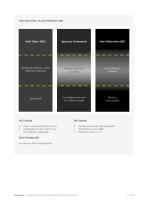
Specular Untreated Moderate reflection: Lamp reflection dispersed Highest reflection: localised Least black Good black when not in a reflection path Blackest Least durable Gross value between 50 and 110 Combination of AR+AG for very low reflection application Standard and white light bandwidth Transmittance up to 98% Reflection down to 1% Anti-Smudge (AS) To repel the effect of fingerprints Densitron | Projected Capacitive Touch Sensor Technology Guide
Open the catalog to page 11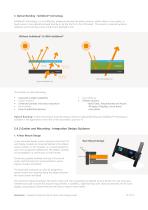
3. Optical Bonding - SolisBond® technology SolisBond® technology is a cost-effective, display-enhancing lamination process, which allows a cover glass, or touchscreen, to be optically bonded directly on to the front of a flat LCD panel. This results in reduced sunshine reflection and minimises a loss of light from backlight units. Without SolisBond® Vs With SolisBond® Cover Lens / Touch Panel Air Gap Cover Lens / Touch Panel SolisBond® Reflection loss about 4% Display Reflection loss about 4% Light from backlight units Light from backlight units The benefits of optical bonding: • • • • •...
Open the catalog to page 12All Densitron Technologies catalogs and technical brochures
-
Densitron-OLED-Brochure
7 Pages
-
Densitron UReady Brochure
6 Pages
-
Introduction to Touch Solutions
14 Pages
-
DensiTouchTM
16 Pages
-
Backlight Technology Overview
18 Pages
Archived catalogs
-
New 1.69" OLED
1 Pages
-
Touch Screens
1 Pages
-
New 0.96" OLED
1 Pages
-
New 7" TFT
1 Pages
-
Corporate Statement
2 Pages
-
Densitron Display Solutions
1 Pages
-
Composite Video
1 Pages
-
Alphanumeric Displays
1 Pages
-
Monographic Displays
2 Pages
-
EL Displays
1 Pages
-
CSTN
4 Pages
-
TFT Displays
4 Pages
-
OLED Displays
2 Pages
-
Evaluation Kits
2 Pages
-
Open Frame Monitors
2 Pages
-
OLED
2 Pages


























